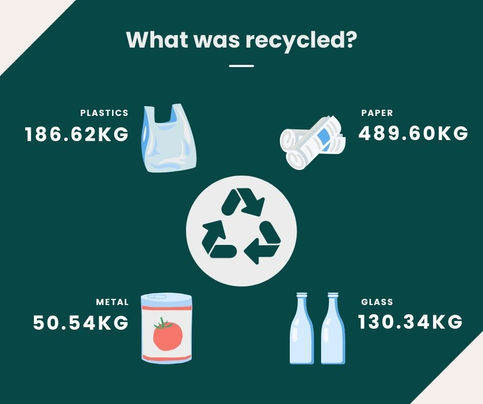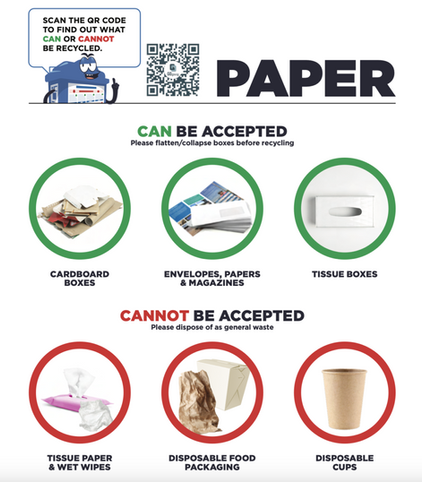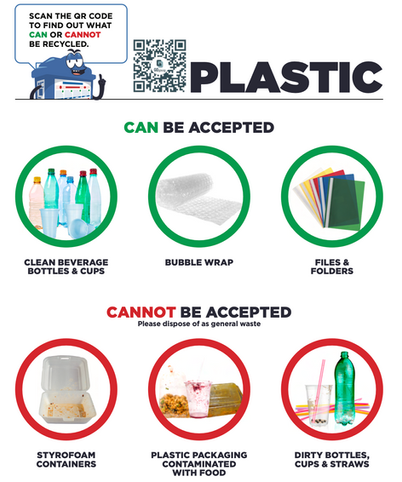Let's Recycle Together
Let's Recycle Together is a movement by Zero Waste SG to encourage more residents to recycle using the blue bins and recycle right. With #recycleright campaigns by the National Environment Agency (NEA), the Bloobin mascot and blooboxes for households, ZWSG's movement complements these efforts by reducing the recycling contamination rate through education and piloting different collection methodologies.
2024
ZERO WASTE SG'S SPECIAL ANNOUNCEMENT!
Given the recycling contamination rates at a consistent high of 40% and domestic recycling rates dropping to an all-time low of 12% in 2022 (statistics by NEA), along with new initiatives in the pipeline such as the Beverage Container Return Scheme (BCRS), Zero Waste SG fine-tuned its Let's Recycle Together movement to focus on waste segregation at source.
CLICK THROUGH THE SORT IT OUT LOGO TO FIND OUT MORE!


2023
Zero Waste SG X Asia Pacific Breweries Singapore X Lions’ Befrienders
LET’S RECYCLE TOGETHER: A COMMUNITY PROGRAMME FOR SENIORS
Based on the latest waste statistics from the National Environment Agency (NEA), our domestic recycling rate in 2022 fell even further from previous year, to just 12%. Coupled with Singapore’s ageing population, Zero Waste SG joined hands with Asia Pacific Breweries Singapore (APBS) to run a 3-month door-to-door collection of recyclables from beneficiaries from Lions Befrienders.
The aims were to enable seniors to remain active contributors to the Zero Waste Masterplan, and collectively meet the goal of raising household recycling to 30% by 2030. This initiative was also in support of NEA’s Recycle Right campaign. See below for the key findings of our pilot, which concluded in November 2023!

2022
MSE Transparent Recycling Bins Pilots
Zero Waste SG partnered with MSE to test if changing the design of our blue bins would help to reduce the recycling contamination rate, which stands at 40%. In particular, the pilots tested if adding a transparent feature or introducing segregation could encourage better recycling behaviour and reduce recycling bin contamination rates.
The findings over the effectiveness of design change were inconclusive. Nevertheless, through our door-to-door survey with residents in the pilot areas, we found that it would be worthwhile to look at better and more accessible public education on recycling right. Some misconceptions that were still prevalent include:
-
Placing textiles, bulky items and Styrofoam into the blue bins. Good-to-use items like clothing or toys should be donated where possible.
-
Treating blue bins like general waste bins and depositing items contaminated by food or other liquids
-
Tissue paper, regardless clean or dirty, should not be put into the blue bins as they are not recycled.
When it comes to modality, consider displaying actual, physical samples of items that can / cannot be accepted as these seem to work better than 2D pictures or posters.
Snapshots of our findings are below. Read our full report here!
Archives (Before 2021)
Let’s Recycle Together is a campaign by Zero Waste SG. We aim to encourage more HDB residents to recycle using the existing blue recycling bins in their estates, and to educate them on recycling correctly.
Background on our ‘Let’s Recycle Together’ Campaign
This ground-up campaign complements the National Recycling Programme by the National Environment Agency (NEA), where the Public Waste Collectors licensed by NEA are required to provide the blue recycling bins and recycling collection for all HDB estates and landed properties in Singapore.
Your neighbours and other families are recycling, join them today and let’s recycle together!
Step 1: Understand Why We Need To Recycle
This ground-up campaign complements the National Recycling Programme by the National Environment Agency (NEA), where the Public Waste Collectors licensed by NEA are required to provide the blue recycling bins and recycling collection for all HDB estates and landed properties in Singapore.
Your neighbours and other families are recycling, join them today and let’s recycle together!


Step 2: Learn How To Recycle At Home
This ground-up campaign complements the National Recycling Programme by the National Environment Agency (NEA), where the Public Waste Collectors licensed by NEA are required to provide the blue recycling bins and recycling collection for all HDB estates and landed properties in Singapore.
Your neighbours and other families are recycling, join them today and let’s recycle together!

Some residents place a recycling bin in their house, while others use a plastic bag or reusable bag for storing their recyclables, it’s up to you!

The National Recycling Programme uses a commingled collection system where all the recyclables go into a single blue recycling bin. According to NEA, the commingled system is convenient for residents as they do not need to sort or make space in their homes to store different recyclables. It also allows for a single-stream collection of recyclables, which is a cost-effective method.
The collection from the recycling bins is done daily or 3 times a week, depending on the sector. You can check the locations of the blue recycling bins at the housing estates in Singapore from the SLA OneMap, and find out more about the Public Waste Collectors and their collection days from NEA.
Step 3: Find Out What Items Can Or Cannot Be Recycled
Check out the list below to learn what items can or cannot be placed into the blue recycling bins at HDB estates! Check this list against NEA’s to ensure it’s the most up to date.




Step 4: Learn What Happens To The Recyclables After Collection

The recycling trucks only collect recyclables from the blue recycling bins and do not collect waste from the rubbish bin centres. The type of trucks used for collecting recyclables and waste might look similar but they are actually separate trucks with different collection schedules. The recycling trucks would usually have a recycling logo on the side of the truck.
Here’s some photos of a Material Recovery Facility operated by one of the Public Waste Collectors. The recyclables are collected by the trucks and sent to the facility, where the recyclables are placed on a conveyor belt and the workers sort them according to material types.



The sorted materials are either exported overseas for recycling or sent to local recycling facilities. Some of the local recycling facilities are listed in the NEA website.
You can also learn more about the recycling process of these materials: Paper; Plastics; Metal; Glass; Food Waste; Wood and Horticultural Waste; Electrical and Electronic Waste; Tyres; and Construction and Demolition Waste.
Images credit and source:
-
Understand Why We Need To Recycle (incineration plant and landfill) – Senoko Waste-to-Energy Plant, Keppel Seghers Pte Ltd, http://www.keppelseghers.com/en/content.aspx?sid=3028#A6-SWTEP
-
Understand Why We Need To Recycle (incineration plant and landfill) – Semakau Landfill, National Environment Agency, http://www.nea.gov.sg/energy-waste/waste-management/semakau-landfill
-
Learn How To Recycle At Home – 3R Poster, National Environment Agency, http://www.nea.gov.sg/docs/default-source/energy-waste/recycling/3r-poster.pdf?sfvrsn=2
-
Learn What Happens To The Recyclables After Collection – 3R Poster, National Environment Agency, http://www.nea.gov.sg/docs/default-source/energy-waste/recycling/3r-poster.pdf?sfvrsn=2
-
Recycle Right Resources, https://www.cgs.gov.sg/recycleright/resources
-
Have you seen Bloobin? (Clean and Green Singapore), https://www.youtube.com/watch?v=jAeqGbJIfJE














